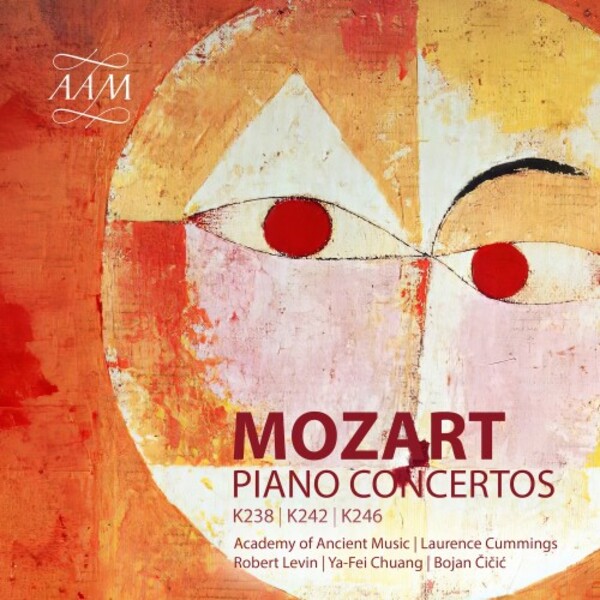MOZART Piano Concertos Nos 6 & 8 (Robert Levin)
View record and artist detailsRecord and Artist Details
Genre:
Orchestral
Label: AAM
Magazine Review Date: 04/2024
Media Format: CD or Download
Media Runtime: 61
Mastering:
DDD
Catalogue Number: AAM044

Tracks:
| Composition | Artist Credit |
|---|---|
| Concerto for Piano and Orchestra No. 6 |
Wolfgang Amadeus Mozart, Composer
Academy of Ancient Music Bojan Cicic, Conductor Robert Levin, Fortepiano |
| Concerto for 3 Pianos and Orchestra, 'Lodron' |
Wolfgang Amadeus Mozart, Composer
Academy of Ancient Music Laurence Cummings, Piano Robert Levin, Fortepiano Ya-Fei Chuang, Piano |
| Concerto for Piano and Orchestra No. 8 |
Wolfgang Amadeus Mozart, Composer
Academy of Ancient Music Bojan Cicic, Conductor Robert Levin, Fortepiano |
Author: David Threasher
For this group of concertos from 1776, Robert Levin turns to the tangent piano, an instrument in which the string is struck by a wooden tangent, as in a clavichord, but that has an escapement action, allowing the string to vibrate freely. The sound is accordingly somewhere between the sustain of the nascent piano and the percussiveness of the harpsichord. Why use such an instrument for these concertos? The principal builder of tangent pianos was one Franz Jakob Späth, whose instruments were favoured by Mozart – until, that is, the following year, when he encountered and transferred his allegiance to the more advanced pianos of Späth’s erstwhile apprentice, Johann Andreas Stein. Späth didn’t only build tangent pianos but it’s not beyond the realms of possibility that Mozart played one in performances of the solo concertos included here.
The effect is fascinating. Listeners are long accustomed to the attenuated tone of the fortepiano when compared to the pianos of today, and the tangent piano goes a step or two further. Yes, it has a tinkly treble that cuts through the texture but its slender dimensions mean it doesn’t ride over the orchestra like later, larger instruments, even with the slimmed-down forces of the AAM, fielding a string section of 4.3.2.2.1. Robert Levin plays with such personality and identification with the music that rather than being lost in the melee, he becomes an equal protagonist peeping out of and then retreating into the orchestral texture. It’s intriguing, and you (metaphorically) lean into the performance to hear clearly what’s going on.
Levin and Ya-Fei Chuang recorded the two-keyboard incarnation of K242 on their previous volume (1/24), using a pair of fortepianos. For the work in its original version, Levin takes the upper part on the tangent piano, Chuang the middle on a fortepiano and director Laurence Cummings the simpler third part (composed for the youngest of the three Lodron sisters) on a harpsichord – three keyboards with widely contrasting actions and means of production, casting a new and enticing light upon a work that is usually performed with more closely matched instruments. The twinkle of the tangent piano is closer to the zing of the harpsichord than the more rounded sound of the fortepiano, rather as if the tangent and harpsichord were conspiring in their twangy frolics, while the fortepiano comes across almost as an adult interloper from another world entirely. All that’s missing from this intriguing and gently provocative album is a parallel recording of one of the movements with the instruments swapped to demonstrate all the sonic possibilities!
Discover the world's largest classical music catalogue with Presto Music.

Gramophone Digital Club
- Digital Edition
- Digital Archive
- Reviews Database
- Full website access
From £8.75 / month
Subscribe
Gramophone Full Club
- Print Edition
- Digital Edition
- Digital Archive
- Reviews Database
- Full website access
From £11.00 / month
Subscribe
If you are a library, university or other organisation that would be interested in an institutional subscription to Gramophone please click here for further information.




